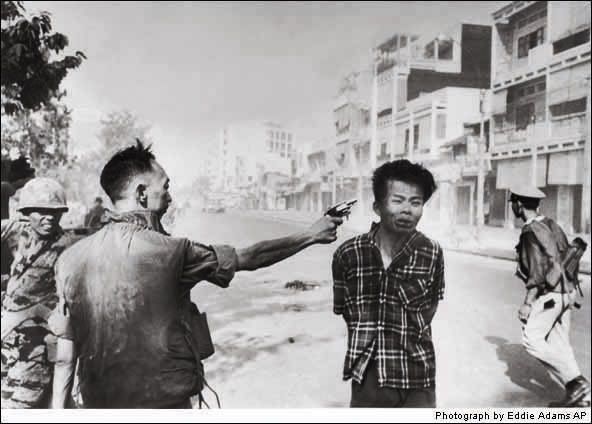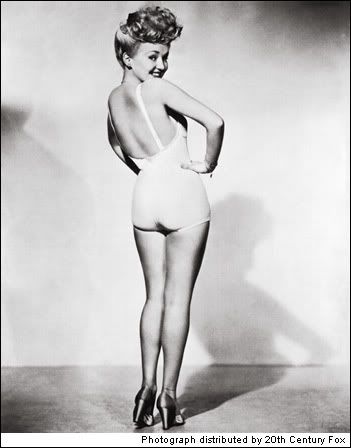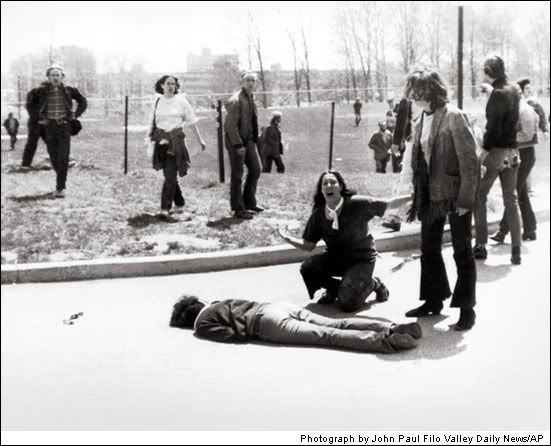
Michael Dukakis, 1988 - Another Landmark Image
After Gary Hart was photographed with a model (no, not his wife) in 1988 on a boat dubbed Monkey Business, Massachusetts Governor Michael Dukakis became the Democrat's choice to run for President against George Bush. At a General Dynamics plant in Michigan, the Duke wanted to show he was no softie on defense, so took a spin in a tank. Compared with the dashing WWII pilot Bush, the little Dukakis came off a clown, and the photo op blew up in his face.

Earthrise 1968
The late adventure photographer Galen Rowell called it “the most influential environmental photograph ever taken.” Captured on Christmas Eve, 1968, near the end of one of the most tumultuous years the U.S. had ever known, the Earthrise photograph inspired contemplation of our fragile existence and our place in the cosmos. For years, Frank Borman and Bill Anders of the Apollo 8 mission each thought that he was the one who took the picture. An investigation of two rolls of film seemed to prove Borman had taken an earlier, black-and-white frame, and the iconic color photograph, which later graced a U.S. postage stamp and several book covers, was by Anders.

Execution of a Viet Cong Guerrilla 1968
With North Vietnam’s Tet Offensive beginning, Nguyen Ngoc Loan, South Vietnam’s national police chief, was doing all he could to keep Viet Cong guerrillas from Saigon. As Loan executed a prisoner who was said to be a Viet Cong captain, AP photographer Eddie Adams opened the shutter. Adams won a Pulitzer Prize for a picture that, as much as any, turned public opinion against the war. Adams felt that many misinterpreted the scene, and when told in 1998 that the immigrant Loan had died of cancer at his home in Burke, Va., he said, “The guy was a hero. America should be crying. I just hate to see him go this way, without people knowing anything about him.”

Betty Grable 1942
World War II took American boys to far-flung places and some rough duty. For many, mail came infrequently at best, and at times it held only a Dear John letter. The troops were desperate for some link to home, some reminder of what they were fighting for. Betty Grable and her million-dollar legs were the perfect balm for what ailed ’em, and this 1942 pinup of the easygoing girl with oodles of back-home charm, and other assets, made the war seem a little more bearable. Sexy pinups later grew to poster size, perhaps most memorably in the endlessly reproduced portrait of Farrah Fawcett.

Johnson Is Sworn In 1963
Lyndon Baines Johnson takes the presidential oath of office on November 22 as Air Force One carries his wife, Lady Bird, Jacqueline Kennedy and several White House aides back to Washington from Dallas. Earlier, President John F. Kennedy had been assassinated, and the speed with which this ceremony was arranged—and the photo released—was purposeful. Johnson and his advisers wanted to assure a shocked nation that the government was stable, the situation under control. Images from the Zapruder film of the shooting, which would raise so many questions, would not be made public for days.

Kent State 1970
When President Richard Nixon said he was sending troops to Cambodia, the nation’s colleges erupted in protest. At Kent State some threw rocks. The Ohio National Guard, called in to quell the turmoil, suddenly turned and fired, killing four; two were simply walking to class. This photo captured a pivotal moment: American soldiers had just killed American kids. Student photographer John Filo won the Pulitzer; the event was also memorialized in a Neil Young song and a TV movie. The girl, Mary Ann Vecchio, turned out not to be a Kent State student, but a 14-year-old runaway. She was sent back to her family in Florida.

Hazel Bryant - Another Landmark Image
It was the fourth school year since segregation had been outlawed by the Supreme Court. Things were not going well, and some southerners accused the national press of distorting matters. This picture, however, gave irrefutable testimony, as Elizabeth Eckford strides through a gantlet of white students, including Hazel Bryant (mouth open the widest), on her way to Little Rock’s Central High.

Tidak ada komentar:
Posting Komentar